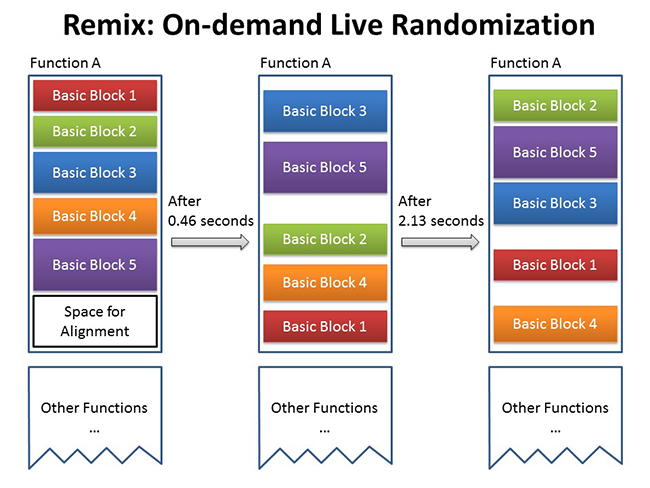作者:Yue CHEN, Florida State University
Address Space Layout Randomization (ASLR) 是神马?
一些攻击,比如return-oriented programming (ROP)之类的代码复用攻击,会试图得到被攻击者的内存布局信息。这样就可以知道代码或者数据放在哪里,来定位并进行攻击。比如可以找到ROP里面的gadget。而ASLR让这些内存区域随机分布,来提高攻击者成功难度,让他们只能通过猜猜猜来进行不断试错的攻击(理想状况下)。图1举了个例子。
(from https://insanitybit.files.wordpress.com/2012/06/aslr.png)
ASLR有啥问题?
在出现了某些漏洞,比如内存信息泄露的情况下,攻击者会得到部分内存信息,比如某些代码指针。传统的ASLR只随机化整个segment,比如栈,堆,或者代码区。这时候攻击者可以通过泄露的地址信息来推导别的信息,比如另外一个函数的地址,等等。这样整个segment的地址都可以推导出来,进而得到更多信息(见图2),大大增加了攻击利用的成功率。而且,在32位系统中,由于随机的熵值不高,攻击者也容易通过穷举猜出地址。
图2: 目前ASLR如何不靠谱
如何改进?
主要的改进方法,一方面是防止内存信息泄露,另一方面是增强ASLR本身。本文主要讨论后者。
1.随机化的粒度可以改进。粒度小了,熵值增加,就很难猜出ROP gadget之类的内存块在哪里。[1](ASLP)在函数级进行随机化,[2](binary stirring)在basic block级进行随机化,[3](ILR)和[4](IPR)在指令级。[3]将指令地址进行随机化;而[4]把指令串进行重写,来替换成同样长度,并且相同语义的指令串。
2.随机化的方式可以改进。[5](Oxymoron)解决了库函数随机化的重复问题: 原先假如每个进程的library都进行fine-grained的ASLR,会导致memory开销很大。该文用了x86的segmentation巧妙地解决了这个问题;并且由于其分段特性,[6](JIT-ROP)之类的攻击也很难有效读取足够多的memory。[7](Isomeron)利用两份differently structured but semantically identical的程序copy,在ret的时候来随机化execution path,随机决定跳到哪个程序copy,有极大的概率可以让JIT-ROP攻击无效。
3.随机化的时间(timing)可以改进。假如程序中存在能泄露内存的漏洞,那这种传统的、一次性的随机化就白费了。所以需要运行时动态ASLR。[8]解决了fork出来的子进程内存布局和父进程一样的缺陷。其思路是在每次fork的时候都进行一次随机化。方法是用Pin进行taint跟踪,找到ASLR之后要修复的指针并进行修复。为了降低把数据当成指针的false positive,一个daemon进程会跑多次来提取出重合的部分。
[9](Remix)提出了一种在运行时细粒度随机化的方法。该方法以basic block为单位,经过一个随机的时间对进程(或kernel module)本身进行一次随机化(图3)。由于函数指针很难完全确认(比如被转换成数据,或者是union类型),该方法只打乱函数内部的basic blocks。该方法另一个好处是保留了代码块的局部性(locality),因为被打乱的basic blocks位置都很靠近。打乱后,需要update指令,以及指向basic block的指针,来让程序继续正确运行。假如需要增加更多的熵值,可以在basic blocks之间插入更多的NOP指令(或者别的garbage data)。
另一种方法[10]是用编译器来帮助定位要migrate的内存位置(指针),并且在每次有输出的时候进行动态随机化。该方法对于网络应用比如服务器,由于其是I/O-intensive的应用,可能会导致随机化间隔极短而性能开销巨大。
图3: Remix:一种ASLR增强的方向
(摘自 http://ww2.cs.fsu.edu/~ychen/paper/Remix_slides.pdf )
参考文献:
[1] C. Kil, J. Jun, C. Bookholt, J. Xu, and P. Ning. Address Space Layout Permutation (ASLP): Towards Fine-Grained Randomization of Commodity Software. In Proceedings of the 22nd Annual Computer Security Applications Conference, 2006.
[2] R. Wartell, V. Mohan, K. W. Hamlen, and Z. Lin. Binary Stirring: Self-randomizing Instruction Addresses of Legacy x86 Binary Code. In Proceedings of the 19th ACM Conference on Computer and Communications Security, 2012.
[3] J. Hiser, A. Nguyen-Tuong, M. Co, M. Hall, and J. W. Davidson. ILR: Where’d My Gadgets Go? In Proceedings of the 33rd IEEE Symposium on Security and Privacy, 2012.
[4] V. Pappas, M. Polychronakis, and A. D. Keromytis. Smashing the Gadgets: Hindering Return-Oriented Programming Using In-place Code Randomization. In Proceedings of the 33rd IEEE Symposium on Security and Privacy, 2012.
[5] M. Backes and S. Nurnberger. Oxymoron: Making fine-grained memory randomization practical by allowing code sharing. In Proceedings of the 23rd USENIX Security Symposium, 2014.
[6] K. Z. Snow, F. Monrose, L. Davi, A. Dmitrienko, C. Liebchen, and A.-R. Sadeghi. Just-in-time Code Reuse: On the Effectiveness of Fine-grained Address Space Layout Randomization. In Proceedings of the 34th IEEE Symposium on Security and Privacy, 2013.
[7] L. Davi, C. Liebchen, A.-R. Sadeghi, K. Z. Snow, and F. Monrose. Isomeron: Code randomization resilient to (just-in-time) return-oriented programming. In Proceedings of the 22nd Network and Distributed Systems Security Symposium, 2015.
[8] K. Lu, S. Nurnberger, M. Backes and W. Lee. How to Make ASLR Win the Clone Wars: Runtime Re-Randomization. In Proceedings of the 23rd Network and Distributed Systems Security Symposium, 2016.
[9] Y. Chen, Z. Wang, D. Whalley and L. Lu. Remix: On-demand live randomization. In Proceedings of the Sixth ACM Conference on Data and Application Security and Privacy, 2016.
[10] D. Bigelow, T. Hobson, R. Rudd, W. Streilein, and H. Okhravi. Timely rerandomization for mitigating memory disclosures. In ACM SIGSAC Conference on Computer and Communications Security, 2015.
作者简介:
Yue CHEN, Florida State University ,博士在读。个人主页:http://yuechen.me











